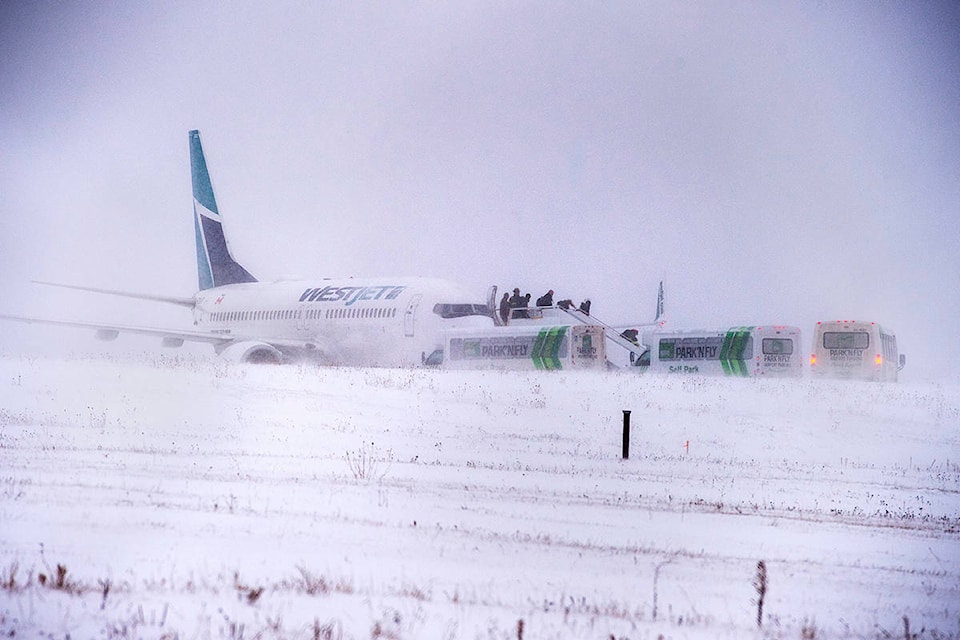A passenger jet skidded off the end of a runway at the Halifax Stanfield International Airport during a snowstorm on Sunday, but a spokeswoman for WestJet said there were no injuries.
The airline confirmed Flight 248 — en route from Toronto to Halifax — landed just after noon and overshot Runway 14 with 172 passengers and seven crew members aboard.
Photos from the scene suggest the Boeing 737-800 escaped major damage. However, the airport authority confirmed the aircraft was left disabled at the end of the runway.
Passenger Eric Wynne, a photographer with the daily Halifax Chronicle-Herald, said the landing was “a little chaotic.”
“It was a little more violent, in that I’m sure (the plane) had a bit of wind shear,” he said in an interview. “As we hit the tarmac, it was rocking, rolling side to side, but the aircrew kept it true and straight.”
Wynne said once the aircraft settled down, everything seemed normal — until the plane came to a stop.
“We saw snow-covered grass outside the windows,” he said. “And then the pilot came on and said we slid off the runway.”
The transition to the grassy area was a smooth one, Wynne said.
“It was just like me driving my car and ending up on the shoulder,” he said, adding that the jet appeared to have travelled about 50 metres beyond the runway.
“It was snowing, but not a lot,” he said. “But there was an accumulation on the ground.”
@TSBCanada has released the aircraft. They will be conducting an investigation into the incident. #WS248
— WestJet (@WestJet) January 5, 2020
Wynne said the crew and passengers remained calm as buses arrived to take them to the terminal.
All passengers were removed from the stricken airplane by 2:30 p.m. However, the plane had yet to be moved by 6 p.m. local time.
The eastern half of the province, including the region east of Halifax, was under a winter storm warning when the jet landed. Heavy snow and whiteout conditions were evident at the airport soon after the plane came down.
ALSO READ: Dozens of flights cancelled in Montreal as ice storm hits Eastern Canada
WestJet spokeswoman Lauren Stewart said the airline later issued an apology to travellers and cancelled three flights into St. John’s, N.L., Halifax and Toronto.
Later in the day, the Transportation Safety Board of Canada confirmed it had sent an investigative team to the airport. The independent agency, which investigates air, rail, marine and pipeline accidents, released the aircraft to WestJet at 4:30 p.m.
On Nov. 7, 2018, a Boeing 747 cargo jet overshot the same runway, plowed through some approach lights and navigation gear, and came close to crashing through the airport’s outer fence.
The SkyLease Cargo plane was badly damaged as it slid 210 metres off the end of the runway in rainy conditions while being buffeted by a crosswind with a potential tailwind.
Flight KKE 4854, which had arrived from Chicago just after 5 a.m., was to be loaded with live lobster destined for China.
At the time, the airport authority was in the process of installing a runway-end safety area, a kind of buffer strip that gives planes extra stopping distance and can reduce damage and risk to passengers in the event of an overrun.
The Transportation Safety Board says all runways longer than 1,800 metres should have a 300-metre runway-end safety area or a means of stopping aircraft that provides an equivalent level of safety. Runway 14 is 2,300 metres long.
Since 2005, there have been 140 runway overruns in Canada, 19 of which have been the subject of a comprehensive TSB investigation.
— With files from Andrew Vaughan.
Michael MacDonald, The Canadian Press
Like us on Facebook and follow us on Twitter.
